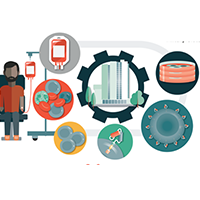Challenges in Developing GMP-Compliant Manufacturing Facilities for CAR-T Cells
Cell Gene Therapy Insights 2018; 4(4), 431-436.
10.18609/cgti.2018.044
Could you give an overview of what type of GMP manufacturing options are currently available for companies developing CAR-T?
There are several different models and options available. The option a company chooses may be highly dependent on their stage of therapeutic development. For example, an early company with limited capital access, might interact with big academic organizations, especially in the United States. For example, Juno arose from an interaction between the Fred Hutchinson Cancer Center, Seattle Children´s Hospital and the Memorial Sloan Kettering Centre. There are academic centers, such as MD Anderson and Baylor College in Houston, which have a long history and good track record for designing, developing T-cells and cell programs.
As a company progresses to commercialization phase of a CAR-T product, complete dependency on an external manufacturing source may not be ideal. Juno, Kite, and Novartis are all examples of companies who opted to build their own manufacturing facilities. In my opinion, there are many advantages to managing your manufacturing, with your own production facilities.
What are the key factors that play into that decision for a company to decide that they’re going to build out an internal facility? And when companies decide to bring manufacturing in-house how do they go about doing it?
There are at least three key factors that weigh into a company’s decision to build out internal manufacturing capabilities. One is product quality. Another is the success of product manufacturing. And the third is perhaps security of supply chain. These therapies require big processes and it’s a key issue to manage the supply chain. Companies want to control all these factors, and that is only possible if they are in the driver seat for these processes.
With respect to how companies build out these facilities, we can take a look at what some have done. For example, Novartis utilizes pre-built facilities, which had previously been used to manufacture cell products. Both Kite and Juno have bought facilities and designed them to fit their processes.
Some companies offer prefabricated GMP facility designs like GE Flex Factories/KUBio – What are your thoughts on these and are you aware whether they are gaining traction in the industry?
Whether pre-fabricated GMP facilities are useful likely depends on the stage of product development cycle. For example, if companies are early stage, these systems may be more useful as compared to companies which are a little later in the product cycle, who have already designed their own processes with different parts from different companies. I suspect that these later-stage companies would not benefit too much from pre-existing GMP facilities.
What key factors are considered in developing GMP-compliant manufacturing facilities for CAR-T?
There has been a huge effort in process research and development for CAR-T. We have learned that one factor is optimized automated systems, good control systems with the respective global external controls of the machines. These closed, automated systems will reduce the workload, especially the manual aspects of the work process dramatically. This may not only decrease the cost of goods, but may also increase productivity.
If you look at indications and output of current labs, it most likely does not cover the demand. So, we think about making more plants, and making those plants more productive in order to meet the production needs of these important drugs.
Obviously, regulatory frameworks differ based on geography, for example the requirements in Asia are different from Europe and the US. Even within Europe the framework differs from country to country. The regulatory framework may influence GMP facility design. But if you adhere to GMP regulation, these likely apply similarly throughout different countries
What are the primary challenges of building out an internal GMP facility?
One key challenge that companies face is finding the volume and quality of staff to manufacture these products. Companies who attract the best people will have the highest likelihood to be successful. There is a strong correlation between experts in the field and the outcome of the products. But these products are very close to science and process development. So, it’s not only manufacturing that is a challenge, it’s really the combination between research, process development and manufacturing. These three components have to work together, because they are much closer interlinked with the cell products compared to chemical entities or even biologics. With these cell therapies, we are earlier in the product knowledge curve, so research has a much higher influence in these processes. Manufacturing should not be considered independent of process development and research.
In your experience at Juno can you share a bit about how the company’s GMP process has evolved as your therapies have progressed into later stages towards commercialization?
While I cannot go into too much detail here, I can say that there was a clear evolution on our products and processes. Each new product has built on the knowledge gained by the previous ones. This has led us to be very optimistic about the clinical and operational performance of both JCAR017 and JCARH125.
Can you share any insights as to what figures are we looking at in terms of cost and time to build out a facility and have it up and running?
In general, a company will start building out roughly 2 years before they want to have it up and running. The planning itself, the numbers themselves depend on the indication being treated, the incidence and number of cases per year. The capacity of the facility needs to be adjusted according to many parameters. The most important one is assessing what demand and what’s the accessible market. Additional considerations are the size of the company, and also the coverage – whether it´s continental coverage or intercontinental coverage of the market – the location of your facilities.
We are seeing many CMOs expanding and building out more GMP space as the demand increases. Are the facility designs at CMOs similar to the designs that are implemented at in-house facilities?
For a CMO, more modular design of the facility enabling the production of different products would make more sense. From my perspective, a company going commercial needs to have production capabilities suited for one or maybe two commercial products. And commercialization needs standardization, to generate a consistent, high-quality product. The CMO must be more flexible, because they have different customers and they change from one project to another. This suggests that CMOs require different design of their facilities as compared to companies that have commercial product.
There’s been a lot of discussion in the industry about ‘GMP in a box’ technologies. Some say they will remove the need for expensive high class cleanrooms, others say it’s too risky to manufacture outside of a high class clean room. What are your thoughts on this?
There is probably a place for ‘GMP in a box’ within the industry, especially for low volume products with a global footprint. If there’s a high degree of automation and a very low risk of contamination, good closure of the process, then this may be amenable to decreasing the room classification. It is possible, and may be the strategy for many of the companies. This strategy decreases the workload, especially for programmes with a batch size of 1. Companies are sensitive to this, and thinking about different strategies of how to deal with this. One is definitely to decrease in the room classification. Whether that will be a concept of the GMP in a box, that I don’t know. At the moment, I would say that standardization of the processes is needed. But I doubt that it will be so simple that it can be standardized to replicate one thousand-fold. In 5 years or so, it may be possible. All this process technology has developed and can now serve as a basis for this kind of GMP in a box context. But right now, I’m not convinced that is already a viable business model.
Another hot topic around manufacturing models are the centralized versus decentralized. Do you have thoughts on how decentralization might affect the development of GMP facilities?
First, we have to describe what is meant by decentralization. Does that mean you have several production plants, or does that mean production comes to key hospitals where you don’t have centralized production plants anymore? Decentralization can mean many things. With the complexity of the processes, the most likely situation will be that companies will have certain plants in certain areas where they kind of cover some geographies with a certain plant and make the products from there in a more centralized manner. However, with the evolution of the processes, I can imagine that decentralization in the sense that you don’t need these highly-specialised plants anymore, and the use of regional CMOs to augment the internal manufacturing network.
As more therapies make their way towards commercialization, what are your thoughts on the types of GMP facilities we can expect to see in the next 5 years?
First, I think that high class clean rooms may be deprioritized. Regulatory bodies may allow processes to take place in lower class clean rooms, decreasing the workload attached to these clean room classes. In addition, different degrees of automation will standardize the processes. Consequently, the success rate for the products may increase and the productivity of plants may increase substantially. To summarize, there may be a decrease in cleanroom requirements and manual labor, and better automation of the processes resulting in a higher output of products.
Do you have any final thoughts that you would like to share?
As I mentioned earlier, the interaction between process research and development is critical. Real process research is needed to understand the cells and their target product profiles within a manufacturing process. The companies who have cross-functional teams of individuals with very diverse backgrounds, including engineering, haematology, immunology, biology, statistics, and medicine will be most likely the companies that will succeed.
Affiliation
Lothar Germeroth
SVP, Juno Therapeutics, Inc.
This work is licensed under a Creative Commons Attribution- NonCommercial – NoDerivatives 4.0 International License.


